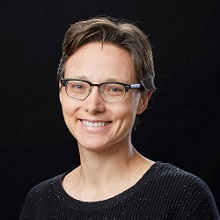-
Title
Director, Center for Computational Engineering -
Email
bramwell1@llnl.gov -
Phone
(925) 423-5074 -
Organization
ENG-ENG PADO-ENGINEERING PAD OFFICE
Professional Experience
Jamie Bramwell is a simulation software project leader primarily working in the Strategic Deterrence and Engineering directorates. She earned her Ph.D. in Computational Science, Engineering, and Mathematics from the University of Texas at Austin and joined LLNL in 2013 as a computational engineer specializing in advanced finite element methods.
Jamie began her career as an integrated code developer on ALE3D, a large-scale multi-physics simulation code supporting Strategic Deterrence. In this role, she was the primary developer for the implicit solid mechanics physics package, which included modern structural element capabilities to facilitate complex mission analysis efforts at NIF and modernization of numerical solver library infrastructure.
In 2017, she joined the MFEM finite element library team as an engineering application specialist. Her work included developing a new cardiac mechanics simulation tool and creating experimental mini-applications for user tutorials and examples. In 2020, she initiated the Smith project, a modular software development kit based on MFEM designed to enable agile development of sensitivity-enabled, high-fidelity engineering-scale simulations.
Currently, Jamie serves as the Director of the Center for Computational Engineering and the Deputy Associate Program Director for the Weapons Simulation and Computing Computational Physics program.
Research Interests
Current areas of interest include integrated multi-physics production code development, sensitivity-enabled simulation, automatic differentiation, high order finite element methods, nonlinear solid mechanics, and modern object-oriented high-performance computing.
PhD, Computational Science, Engineering, and Mathematics, University of Texas at Austin, 2013
MS, Computational and Applied Mathematics, University of Texas at Austin, 2011
BS, Mechanical Engineering, Northwestern University, 2006
Anderson, Robert, et al. "MFEM: A Modular Finite Element Methods Library." Computers & Mathematics with Applications, vol. 81, Jan. 2021, pp. 42-74. ScienceDirect, doi:10.1016/j.camwa.2020.06.009.
Bramwell, Jamie A., et al. SERAC. Computer Software. https://github.com/LLNL/serac. USDOE National Nuclear Security Administration (NNSA). 21 Oct. 2019. Web. doi:10.11578/dc.20200303.2.
Karlin, Ian, et al. "Preparation and Optimization of a Diverse Workload for a Large-Scale Heterogeneous System." Proceedings of the International Conference for High Performance Computing, Networking, Storage and Analysis, Association for Computing Machinery, 2019, pp. 1-17. ACM Digital Library, doi:10.1145/3295500.3356192.
Noble, Charles R., et al. ALE3D: An Arbitrary Lagrangian-Eulerian Multi-Physics Code. United States: N. p., 2017. Web. doi:10.2172/1361589.
Bramwell, Jamie A. A Discontinuous Petrov-Galerkin Method for Seismic Tomography Problems (doctoral thesis). May 2013. repositories.lib.utexas.edu.
Bramwell, Jamie, et al. "A Locking-Free hp-DPG Method for Linear Elasticity with Symmetric Stresses." Numerische Mathematik, vol. 122, no. 4, Dec. 2012, pp. 671-707. Springer Link, doi:10.1007/s00211-012-0476-6.
Niemi, Antti H., et al. "Discontinuous Petrov-Galerkin Method with Optimal Test Functions for Thin-Body Problems in Solid Mechanics." Computer Methods in Applied Mechanics and Engineering, vol. 200, no. 9, Feb. 2011, pp. 1291-300. ScienceDirect, doi:10.1016/j.cma.2010.10.018.


